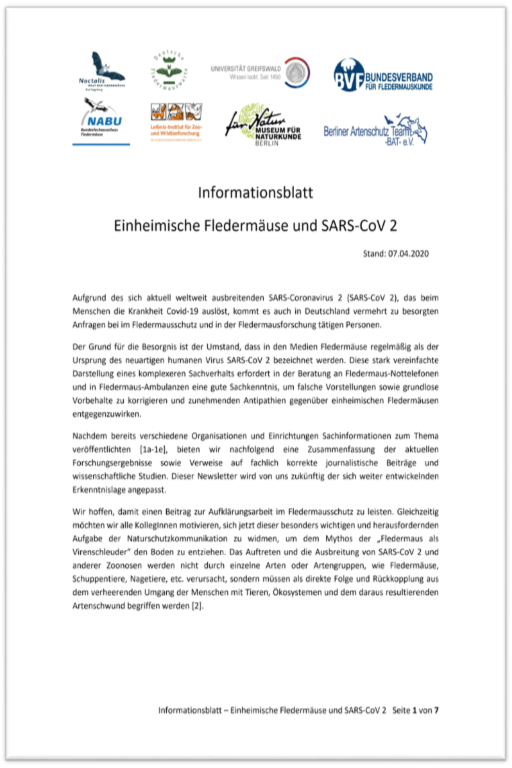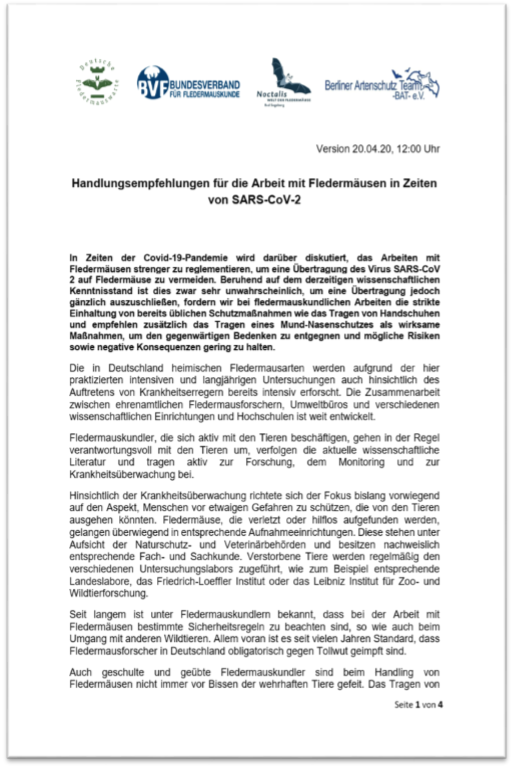The Corona crisis has also had an impact on bats and people dealing with animals. There are reports of the persecution and killing of bats around the world because they are accused of being the source of the novel corona virus. In cooperation between Fledermauswarte, Noctalis, Bundesverband für Fledermauskunde e.V., Leibniz-IZW Berlin, Leibniz Institute for Evolutionary and Biodiversity Research of the Museum of Natural History Berlin, University of Greifswald, NABU BFA Bats and the Berlin Species Conservation Team, a fact paper was compiled in the spring of this year in which the current scientific status was compiled. This paper is intended to help bat workers to educate the society science-based that there is no danger from the bats.
On the other hand, however, caution is required due to the level of knowledge so far: some scientists believe that the virus could be transmitted from humans to bats. In a new study by the Friedrich-Löffler-Institut, flying dogs have been infected with the virus.1 Other scientific studies also show that bats, among other mammals, may be susceptible to SARS COV2.2.3.4 However, it is not yet clear whether European bats can actually become infected and whether bats can become a new reservoir for the virus – but it cannot be ruled out! For this reason, in cooperation with some of the bat organisations mentioned, a further recommendation for action has been developed, which shows effective protective measures to be taken into account when working with bats. Additionally, similar recommendations for action have also been published at international level (e.g. EUROBATS, IUCN) and call on all bat experts to take these recommendations into account accordingly.
1 Schlottau, K., M. Rissmann, A. Graaf, J. Schön, J. Sehl, C. Wylezich, D. Höper, T. C. Mettenleiter, A. Balkema-Buschmann, T. Harder, C. Grund, D. Hoffmann, A. Breithaupt, and M. Beer. 2020. SARS-CoV-2 in fruit bats, ferrets, pigs, and chickens: an experimental transmission study. The Lancet Microbe. S2666524720300896.
2 Damas, J., G. M. Hughes, K. C. Keough, C. A. Painter, N. S. Persky, M. Corbo, M. Hiller, K.-P. Koepfli, A. R. Pfenning, H. Zhao, D. P. Genereux, R. Swofford, K. S. Pollard, O. A. Ryder, M. T. Nweeia, K. Lindblad-Toh, E. C. Teeling, E. K. Karlsson, and H. A. Lewin. 2020. Broad host range of SARS-CoV-2 predicted by comparative and structural analysis of ACE2 in vertebrates. Proceedings of the National Academy of Sciences. 202010146.
3 Olival, K. J., P. M. Cryan, B. R. Amman, R. S. Baric, D. S. Blehert, C. E. Brook, C. H. Calisher, K. T. Castle, J. T. H. Coleman, P. Daszak, J. H. Epstein, H. Field, W. F. Frick, A. T. Gilbert, D. T. S. Hayman, H. S. Ip, W. B. Karesh, C. K. Johnson, R. C. Kading, T. Kingston, J. M. Lorch , I. H. Mendenhall, A. J. Peel, K. L. Phelps, R. K. Plowright, D. M. Reeder, J. D. Reichard, J. M. Sleeman, D. G. Streicker, J. S. Towner, and L.-F. Wang. 2020. Possibility for reverse zoonotic transmission of SARS-CoV-2 to free-ranging wildlife: A case study of bats. PLOS Pathogens. 16: e1008758.
4 Yan, H., H. Jiao, Q. Liu, Z. Zhang, X. Wang, M. Guo, B.-J. Wang, K. Lan, Y. Chen, and H. Zhao. 2020. Many Bat Species Are Not Potential Hosts of SARS-CoV and SARS-CoV-2: Evidence from ACE2 Receptor Usage. Ecology.
PDF’s for download:


